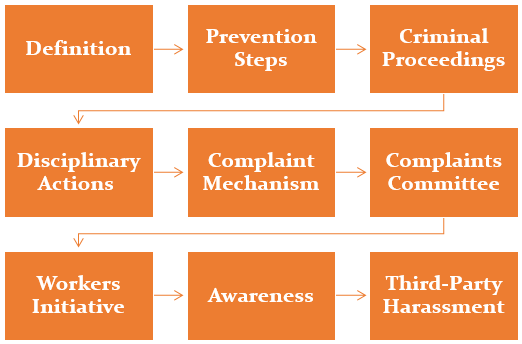
In the Vishaka case, the Apex Court held that each incident of sexual harassment of women at the workplace is a violation of the right to life under Article 21, which implies the right to dignity. According to the court, the principle of gender equality includes protection from sexual harassment and the right to work with dignity, which had been reflected in International Conventions and norms. The Supreme Court went on to hold that it is the primary responsibility for ensuring such safety and dignity of women through suitable legislation and executive action.
However, in the absence of existing protective mechanisms, the Supreme Court evolved certain guidelines to deal with instances of sexual harassment resulting in the violation of important fundamental rights of women workers under Articles 14, 19, and 21.
Vishaka & Others v. the State of Rajasthan
In this case, Bhanwari Devi, a social worker, was gang-raped in a remote Rajasthan village for trying to prevent child marriage. A woman’s organization called ‘Vishaka’ filed a writ in the Supreme Court. Their grievance was that, while working women remained vulnerable to Sexual Harassment at the workplace, neither the legislature nor the executive Government was taking any effective preventive measure on this behalf. Therefore, the Plaintiffs approached the Supreme Court of India for the enforcement of the Fundamental Rights of the working women as guaranteed by the constitution.
Duty of the employer or other responsible persons in workplaces and other institutions
It shall be the duty of the employer or other responsible persons in workplaces or other institutions to prevent or deter the commission of acts of Sexual Harassment and to provide the procedures for the resolution, settlement, or prosecution of acts of Sexual Harassment by taking all steps required.

Definition – For this purpose, Sexual Harassment includes such unwelcome sexually determined behavior (whether directly or by implication) as:
- Physical contact and advances;
- A demand or request for sexual favors;
- Sexually colored remarks;
- Showing pornography;
- Any other unwelcome physical, verbal or non-verbal conduct of sexual nature.
Where any of these acts is committed n circumstances where under the victim of such conduct has a reasonable apprehension that in relation to the victim’s employment or work whether she is drawing a salary, or honorarium or voluntary, whether in Govt., public or private enterprise such conduct can be humiliating and may constitute a health and safety problem.
Prevention Steps: All employers or persons in charge of the workplace whether in the public or private sector should take appropriate steps to prevent Sexual Harassment without prejudice to the generality of this obligation they should take the following steps:
- Express prohibition of Sexual Harassment as defined above at the workplace should be notified, published, and circulated inappropriate ways.
- The rules/regulations of Govt. and public sector bodies relating to conduct and discipline should include rules/regulations prohibiting Sexual Harassment and provide for appropriate penalties in such rules against the offender.
- As regard to Pvt. Employers, steps should be taken to include the aforesaid prohibitions in the standing orders under the industrial employment (standing orders) Act, 1946.
- Appropriate works conditions should be provided in respect of work, leisure, health, and hygiene to further ensure that there is no hostile environment towards women at workplaces and no employee woman should have reasonable grounds to believe that she is disadvantaged in connection with her employment.
Criminal Proceedings – Where such conduct amounts to a specific offense under the IPC or under any other law, the employer shall initiate appropriate action in accordance with law by making a complaint with the appropriate authority.
Disciplinary Actions – Where such conduct amounts to misconduct in employment as defined by the relevant service rules, appropriate disciplinary action should be initiated by the employer in accordance with those rules.
Complaint Mechanism – Whether or not such conduct constitutes an offense under law or a breach of the service rules, an appropriate complaint mechanism should be created in the employer’s organization for redress of the complaint made by the victim. Such a complaint mechanism should ensure the time-bound treatment of complaints.
Complaints Committee – The complaint mechanism, referred to in (6) above, should be adequate to provide, where necessary, a complaint committed, a special counselor or another support service, including the maintenance of confidentiality.
The complaints committee must make an annual report to the Govt. department concerned about the complaints and action to taken by them. The employers and person in charge will also report on the compliance with the aforesaid guidelines including on the reports of the complaints committee to the Govt. Deptt.
Workers Initiative – Employers should be allowed to raise issues of Sexual Harassment at workers’ meetings and is another appropriate forum and it should be affirmatively discussed in employer–Employee Meetings.
Awareness – Awareness of the rights of female employees in this regard should be created in particular by prominently notifying the guidelines (and appropriate legislation when enacted on the subject) in a suitable manner.
Third-Party Harassment – Where Sexual Harassment occurs as a result of an act or omission by any third party or outsider, the employer and person in charge will take all steps necessary and reasonable to assist the affected person in terms of support and preventive action.
The Central / State Govt. are requested to consider adopting suitable measures including legislation to ensure that the guideline laid down by this order are also observed by the employers in Pvt. Sector. These guidelines will not prejudice any rights available under the Protection of Human Rights Act, 1993.
Post Vishaka Guidelines
Vishaka’s judgment was delivered in 1997 and for six years after that, no efforts were made in the direction of enacting a law. So the guidelines continued to be the law required to be followed across the country
Around the same time, many women who were being sexually harassed started breaking their silence and started demanding action from the employers. In fact, a number of this case arose from university and college campuses. The response of the employers, by and large, was to sweep such cases under the carpet and at times even to victimize the woman.
The court held that the Vishaka Guidelines should not remain just symbolic but rather shall provide direction and held that states had not done everything required to comply with the guidelines.


